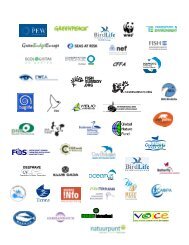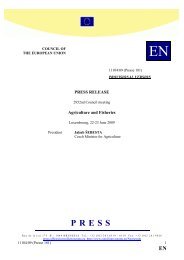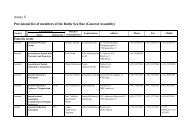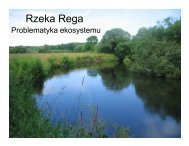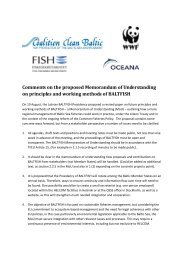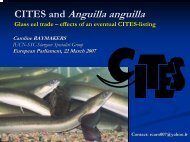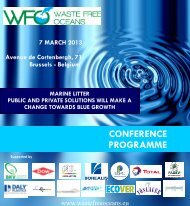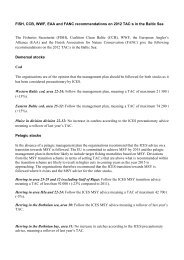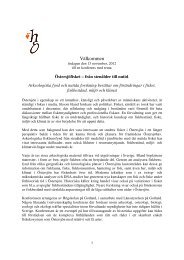A report on iUU fishing of Baltic Sea cod - Fisheries Secretariat
A report on iUU fishing of Baltic Sea cod - Fisheries Secretariat
A report on iUU fishing of Baltic Sea cod - Fisheries Secretariat
Create successful ePaper yourself
Turn your PDF publications into a flip-book with our unique Google optimized e-Paper software.
Fishing in closed areasEU fisheries regulati<strong>on</strong>s provide for seas<strong>on</strong>al,temporary and permanently closed areas to allor specified forms <strong>of</strong> <strong>fishing</strong>. On occasi<strong>on</strong>, somefishermen are known to deliberately breach theseregulati<strong>on</strong>s. Indeed, in 2005 Polish fishermenc<strong>on</strong>ducted a mass dem<strong>on</strong>strati<strong>on</strong> against theseas<strong>on</strong>al closure <strong>of</strong> the <strong>cod</strong> fishery by <strong>fishing</strong> duringa closed period. However, the extent to whichdeliberate <strong>fishing</strong> in closed areas takes place isuncertain.Unless a vessel is boarded in the act <strong>of</strong> <strong>fishing</strong>or without their nets appropriately stowed, itis extremely difficult to prove that they are orhave been <strong>fishing</strong>. While VMS will c<strong>on</strong>firm thata vessel is in transit within a closed area it willnot c<strong>on</strong>firm, without reas<strong>on</strong>able doubt, that it is<strong>fishing</strong>.Landing undersized <strong>cod</strong>The minimum landing size (MLS) for <strong>cod</strong> fromthe <strong>Baltic</strong> is 38 cm. This means that any <strong>cod</strong> underthis length should not be landed. The catching,retaining and landing <strong>of</strong> undersized <strong>cod</strong> washighlighted as an occasi<strong>on</strong>al widespread problemand <strong>of</strong>ten associated with a str<strong>on</strong>g year classentering the fishery at, or close to, the MLS.As a result <strong>of</strong> the comparatively str<strong>on</strong>g 2003 yearclass, more small <strong>cod</strong> are presently recruitingto the fishery and this has apparently coincidedwith an increase in landings <strong>of</strong> undersized fish.ICES estimate, that in 2004, 47% <strong>of</strong> the <strong>cod</strong>caught in the eastern <strong>Baltic</strong> <strong>Sea</strong> were 3 years oldor younger and 34% were 4 years old.Individuals involved in discard sampling in Sweden<str<strong>on</strong>g>report</str<strong>on</strong>g>ed that landing <strong>of</strong> undersized <strong>cod</strong> wasmore prevalent in some inshore areas where <strong>cod</strong>stocks have declined or become less comm<strong>on</strong>.Apparently some fishermen have the attitude thatthey cannot afford to wait for the <strong>cod</strong> to growany bigger and/or be left for others to catch.In Poland, there appears to be a market forundersized <strong>cod</strong> – or “bolek” – and it was suggestedthat this was <strong>on</strong>e <strong>of</strong> the reas<strong>on</strong>s that someapparently good year classes had not resulted inthe predicted increase in stocks.The MLS increased from 33 cm to 35 cm in2002, with a further increase in 2003 to thepresent 38 cm. It was suggested that these changesmay be a c<strong>on</strong>tributing factor in the apparentc<strong>on</strong>tinued landing <strong>of</strong> small <strong>cod</strong>, with some fishermenunable to get out <strong>of</strong> the habit or mindset <strong>of</strong>catching and keeping, what are now, undersizedfish. Limited or ineffective enforcement plus amarket for small <strong>cod</strong> will likely mean that thelanding <strong>of</strong> undersized <strong>cod</strong> will c<strong>on</strong>tinue.Small mesh size or illegal rigging <strong>of</strong> gearThe increase in MLS has also been coupled withthe required use <strong>of</strong> more size-selective <strong>fishing</strong>gear such as the BACOMA trawl. However, withthe apparent market and the potential mindset <strong>of</strong>fishermen to catch and retain undersize <strong>cod</strong>, instances<strong>of</strong> rigging <strong>fishing</strong> gear so that mesh sizeswere restricted have been <str<strong>on</strong>g>report</str<strong>on</strong>g>ed.The gillnet fishery tends to target larger fish andso it was suggested that the landing <strong>of</strong> undersizedfish and the illegal rigging <strong>of</strong> gear were morelikely and characteristic <strong>of</strong> the trawl fishery.“Targeted” bycatchPelagic vessels are allowed a maximum 3%bycatch <strong>of</strong> <strong>cod</strong>. Some vessels are known to occasi<strong>on</strong>allyand deliberately exceed this limit. Iflanding inspecti<strong>on</strong> is avoided, then the bycatchwill go undetected.When inspectors m<strong>on</strong>itor the landing from apelagic vessel, visual inspecti<strong>on</strong> and sampling areused to indicate the percentage bycatch. It takesan experienced inspector to be able to estimatethe percentage <strong>of</strong> <strong>cod</strong> bycatch, particularly as theprocess <strong>of</strong> landing pelagic species does not necessarilyeasily lend itself to inspecti<strong>on</strong>. Pelagic speciesare <strong>of</strong>ten rapidly pumped from the fish holdsashore in large quantities. This is in c<strong>on</strong>trast to<strong>cod</strong> and other demersal species that are comm<strong>on</strong>lyboxed and winched ashore. It was suggestedthat the bycatch would need to be significantlyabove the 3% before some inspectors have thec<strong>on</strong>fidence to suspend a landing and take appropriateacti<strong>on</strong>.Exceeding 48 hour soak time for gillnetsExceeding the 48 hour soak time for gillnets washighlighted as a comm<strong>on</strong> complaint by trawlerfishermen. It was unclear as to whether this is a– 18 –



